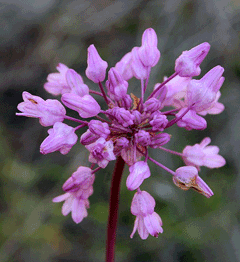 |
|
http://commons.wikimedia.org/wiki/User:Calibas |
 |
| http://flickr.com/photos/randomtruth/ |
Translate this page:
Summary
Physical Characteristics

 Dichelostemma volubile is a CORM growing to 3.6 m (11ft 10in).
Dichelostemma volubile is a CORM growing to 3.6 m (11ft 10in).
See above for USDA hardiness. It is hardy to UK zone 9. It is in flower in July. The species is hermaphrodite (has both male and female organs).
Suitable for: light (sandy) and medium (loamy) soils and prefers well-drained soil. Suitable pH: mildly acid, neutral and basic (mildly alkaline) soils. It can grow in semi-shade (light woodland) or no shade. It prefers dry or moist soil.
UK Hardiness Map
US Hardiness Map
Synonyms
Brodiaea volubilis. (Moriere.)Baker. D. californicum. Stropholirion californicum.
Plant Habitats
Woodland Garden Sunny Edge; South Wall. By. West Wall. By.
Edible Uses
Edible Parts: Root
Edible Uses:
Corm - raw or cooked[105, 161, 257].
References More on Edible Uses
Medicinal Uses
Plants For A Future can not take any responsibility for any adverse effects from the use of plants. Always seek advice from a professional before using a plant medicinally.
None known
References More on Medicinal Uses
The Bookshop: Edible Plant Books
Our Latest books on Perennial Plants For Food Forests and Permaculture Gardens in paperback or digital formats.

Edible Tropical Plants
Food Forest Plants for Hotter Conditions: 250+ Plants For Tropical Food Forests & Permaculture Gardens.
More

Edible Temperate Plants
Plants for Your Food Forest: 500 Plants for Temperate Food Forests & Permaculture Gardens.
More

More Books
PFAF have eight books available in paperback and digital formats. Browse the shop for more information.
Shop Now
Other Uses
References More on Other Uses
Cultivation details
Prefers a rich sandy loam and a well-drained soil[1]. Succeeds in most soils and situations so long as the ground is well-drained[42]. Likes plenty of moisture whilst in growth, followed by a warm dry period in late summer to autumn[200]. Plants are not very hardy and may require protection in severe winters[1]. This can be provided by applying a good organic mulch such as dry bracken in late autumn and removing it in the spring. Alternatively, you can cover the ground with a cloche or similar device. Plants are susceptible to rot in wet winters. Plants are often found growing with Rhus toxicodendron in the wild[90]. A very ornamental plant, it can flower in 2 years from seed.
References Carbon Farming Information and Carbon Sequestration Information
Temperature Converter
Type a value in the Celsius field to convert the value to Fahrenheit:
Fahrenheit:
The PFAF Bookshop
Plants For A Future have a number of books available in paperback and digital form. Book titles include Edible Plants, Edible Perennials, Edible Trees,Edible Shrubs, Woodland Gardening, and Temperate Food Forest Plants. Our new book is Food Forest Plants For Hotter Conditions (Tropical and Sub-Tropical).
Shop Now
Plant Propagation
Seed - best sown as soon as it is ripe in a free-draining compost in a cold frame[200]. Sow stored seed in spring in a cold frame[175]. Seedlings are prone to damping off and so should be kept well ventilated[175]. Germinates in 1 - 3 months at 15°c[175]. If the seed is sown thinly enough, it can be grown on for its first year without transplanting and then the dormant bulbs can be planted 2/3 to a pot. Otherwise prick out the seedlings when large enough to handle, planting them 2/3 to a pot. Grow on the plants in a greenhouse for at least two years before planting out in late spring after the last expected frosts. Division in autumn of offsets that have reached flowering size[1]. Dig up the clumps of bulbs and replant the larger ones into their permanent positions. It is best to pot up the smaller ones and grow them on for a year in a cold frame before planting them out.
Other Names
If available other names are mentioned here
Native Range
NORTHERN AMERICA: United States (California)
Weed Potential
Right plant wrong place. We are currently updating this section.
Please note that a plant may be invasive in one area but may not in your area so it's worth checking.
Conservation Status
IUCN Red List of Threatened Plants Status :

Growth: S = slow M = medium F = fast. Soil: L = light (sandy) M = medium H = heavy (clay). pH: A = acid N = neutral B = basic (alkaline). Shade: F = full shade S = semi-shade N = no shade. Moisture: D = dry M = Moist We = wet Wa = water.
Now available:
Food Forest Plants for Mediterranean Conditions
350+ Perennial Plants For Mediterranean and Drier Food Forests and Permaculture Gardens.
[Paperback and eBook]
This is the third in Plants For A Future's series of plant guides for food forests tailored to
specific climate zones. Following volumes on temperate and tropical ecosystems, this book focuses
on species suited to Mediterranean conditions—regions with hot, dry summers and cool, wet winters,
often facing the added challenge of climate change.
Read More
Expert comment
Author
(Kellogg.)A.A.Heller.
Botanical References
171270
Links / References
For a list of references used on this page please go here
Readers comment
© 2010, Plants For A Future. Plants For A Future is a charitable company limited by guarantee, registered in England and Wales. Charity No. 1057719, Company No. 3204567.